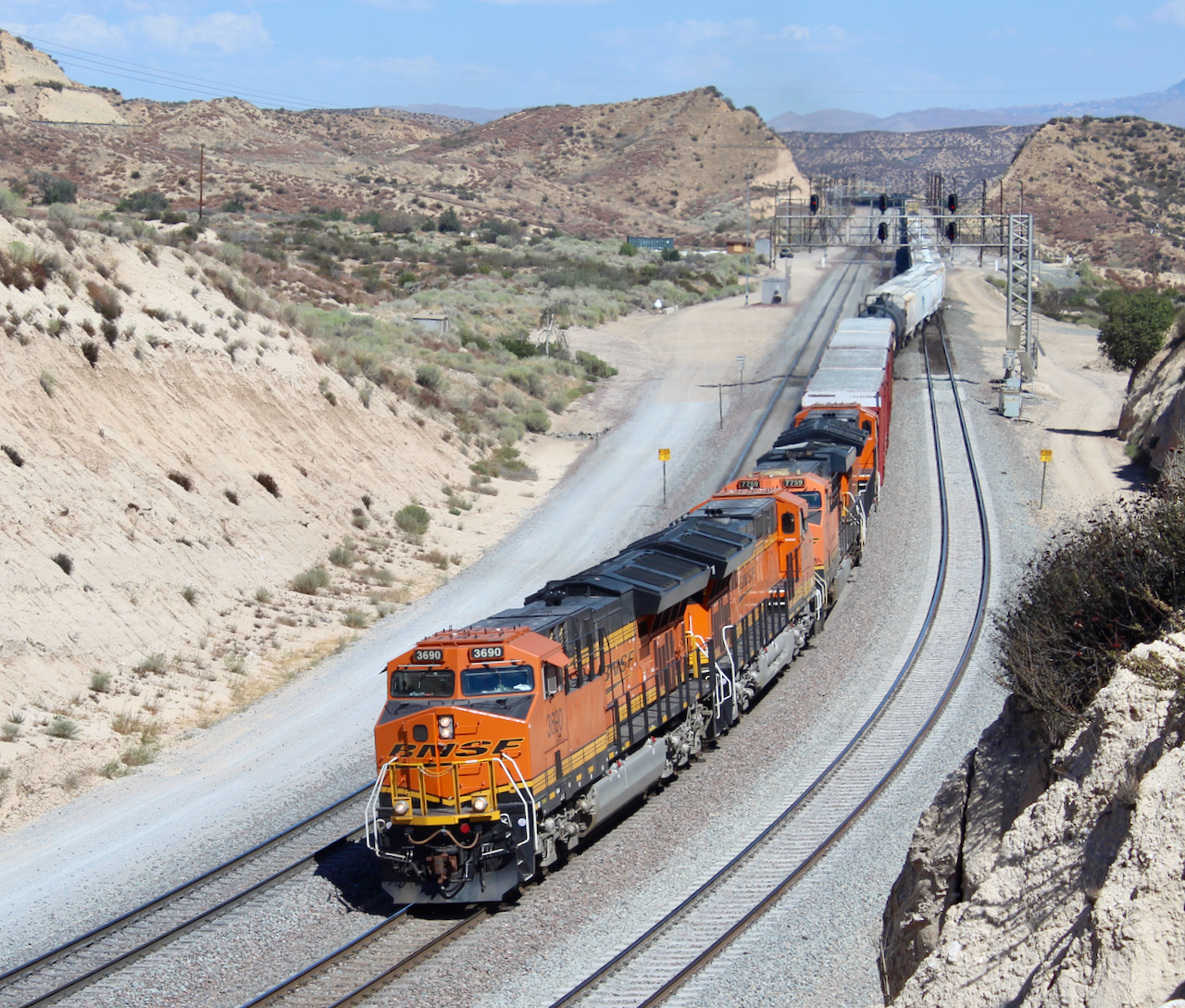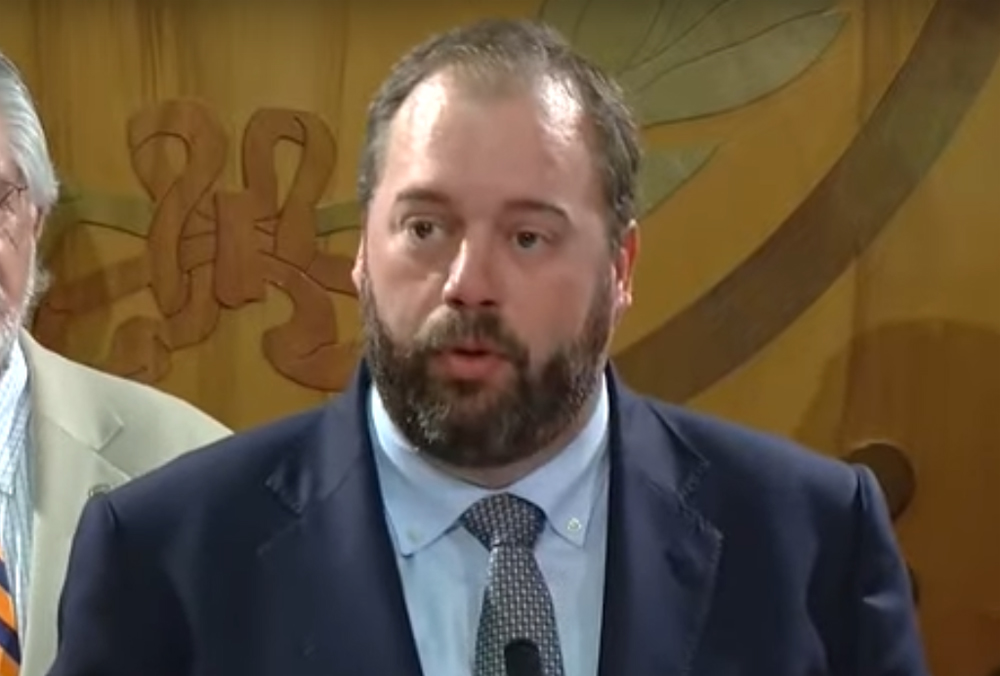
FORT WORTH, Texas — BNSF Railway’s merchandise network is now running better than it has in years due to a focus on improving terminal operations.
BNSF began looking at ways to unclog its yards earlier this year, an effort that was accelerated in July after the railroad brought in veteran operations guru Ed Harris, a consultant who has served as chief operating officer at three Class I railroads.
Merchandise train velocity is currently at its highest level since 2020. Average hump yard dwell last month, at 25.2 hours, was the best in a decade. Four of the railway’s eight hump yards – at Kansas City, Kan., Galesburg, Ill., Lincoln, Neb., and Barstow, Calif. – set new record low dwell figures in September. Six humps have set record train on-time departure levels for the past two months, while flat switching yards in Laurel, Mont., Denver, and Amarillo, Texas, also set records.
“As the biggest intermodal operator by far, BNSF has recently been taking its expertise in intermodal terminals and applying that with more structure and rigor to its eight hump yards,” spokesman Zak Andersen says. “Terminals and humps are somewhat different animals, but there are still lessons to be learned and applied, and operations management has been methodically working through the eight humps and seeing notable success.”
The four BNSF computer systems that play a role in yard productivity are more tightly integrated, and the railroad has brought its service design function into the Transportation Department. “This has materially accelerated the improvement cycle in terms of adjusting the operating plan to better mesh and evolve with yard operations,” Andersen says.
The yard efficiency initiative puts an emphasis on having all departments — from field operations and service design to the Network Operations Center and continuous improvement team — rigorously adhere to terminal processes, including departing on time.
Harris, 74, emphasized the importance of on-time departures and running to plan in his second stint as chief operating officer at Canadian National, which ended with his retirement last year. He had served as a consultant at CN prior to being named COO in 2022.
At BNSF, Harris hit the ground running in July, and got into the operational weeds by making phone calls to chief dispatchers, superintendents, yardmasters, and trainmasters. Some of the operating officials were not yet aware that Harris was on the property and were caught off guard by his detailed line of probing questions. “Who the hell was that guy?” one operating official asked after hanging up the phone.
BNSF says bringing in consultants is a normal course of business, and that CEO Katie Farmer and Chief Operating Officer Matt Igoe wanted an outsider’s perspective. “That is something we have done across our history, reflecting our commitment to continuous improvement,” Andersen says. “Ed has deep experience in merchandise operations, and he has provided great insight on ways we can continue improving our merchandise customers’ service experience.”
Harris’s gig at BNSF was known in railroad circles. The Wall Street Journal, in a story featured prominently on its website today, noted that BNSF had brought in an expert in Precision Scheduled Railroading to fine-tune its operations.
And that prompted the newspaper to revisit the question of whether BNSF was adopting the operating model that has drawn criticism from organized labor, regulators, and railroad customers. BNSF has been the lone holdout as the low-cost operating philosophy spread to the U.S. from the Canadian railways.
The topic has come up periodically since CEO E. Hunter Harrison implemented PSR at CSX in 2017. After CSX posted dramatic financial improvements, Union Pacific, Norfolk Southern, and Kansas City Southern hopped on the PSR bandwagon.
“BNSF never was a PSR railroad and isn’t becoming one now,” Igoe told the Wall Street Journal. “Many of the practices now broadly described as PSR were best practices that BNSF utilized long before the PSR moniker existed.”
Harris isn’t the first consultant with PSR experience that BNSF has hired. Mike Farrell, a former Canadian National and Canadian Pacific operating official who led some of Norfolk Southern’s PSR-related operational changes from 2018 through 2022, also served as a consultant at BNSF earlier this year.
Warren Buffett, chairman of BNSF parent Berkshire Hathaway, and Greg Abel, the Berkshire vice chairman who oversees the railway, said this year that they have been disappointed in BNSF’s financial performance. The railroad, they said, needs to improve its profit margins, which have slipped compared to the rest of the industry.
Abel told investors at Berkshire Hathaway’s annual meeting in May that overall freight volume is expected to be flat, so the railway must bring its cost structure in line with demand in order to effectively compete with other railroads and trucks. BNSF is “100% committed” to reducing costs through examining the way its yards, locomotives, and employees are used, Abel said at the time.
Harris worked with Harrison at Illinois Central and CN. He was CN’s chief operating officer from 2005 to 2007, and again from November 2022 to until his retirement in November 2023. Harris also served as chief operating officer at Canadian Pacific from 2010 to 2011, at CSX from 2018 to 2019, and was vice president of operations at Illinois Central when it was acquired by CN in 1998.
During his last tour as CN’s operations chief, Harris aimed to make operations more efficient and service more reliable by focusing on on-time train departures and running trains to siding length.
“Tighter schedule adherence … is near and dear to my heart,” Harris said in January 2023. “We stay with the schedule seven days a week and we run the same schedule every day. If the traffic’s there, we’re going. If the traffic’s not there, we’re going. Whether it’s 120 cars or 40 cars, we’re leaving on time. That’s really the secret of the business, the way I was brought up.”
Independent rail analyst Anthony B. Hatch says BNSF picked the right consultant to help refine its operations.
“He’s the Edwin Jackson of railroading — he’s been everywhere, man,” Hatch said, referring to the Major League Baseball pitcher who set a record by playing for 14 different teams. “I think he is a good fit as a coach/mentor, the role he played at CSX and at his second stint at CN. They don’t need or want a tear-down but a more collegial uplift, and that’s Ed’s specialty.”
Rick Paterson, an analyst with Loop Capital Markets who closely follows railroad performance metrics, says BNSF’s operational gains over the span of a few months are impressive.
“While this is all very encouraging, it only matters if it’s sustainable, so time will tell. These improvements have also occurred in a modest volume pressure tailwind, with BN’s merchandise volumes down 2% [year over year] so far in Q3,” Paterson wrote in an Aug. 30 note to clients. “Regardless, the renewed focus, effort, and initial results is good news for BNSF’s merchandise customers, where service is primarily reliant on the humps, local operations, and mainline performance.”
Last month BNSF’s overall weekly volume topped 200,000 units, the threshold at which the railroad considers itself to be busy.














It’s interesting that Harris has been at several railroads but never for more than two years since PSR got started. Abel, like Wall Street, has been fixated on the operating ratio for many years, and doesn’t seem to understand that transportation is a service business. UPS and J.B. Hunt don’t do business with the BNSF because it’s low cost. Matt Rose reportedly retired early because of it.
Ed Harris and Hunter Harrison focused on the fundamentals – railroading is a 24/7/52 repetitive business. You do what you do with boring regularity matched with openness to change. In the late 1970s, Southern Railway advertised that they wanted their customers to “be able to set your clocks by us.” Would that we could get such regularity in our transportation system.
Let’s translate this article into from Doube Plus Ungood Duckspeak, into English. BNSF was doing just fine, better than any of the other majors. Then Ed Harris was brought in to impose PSR and lower the operating ratio. Ed Harris begins by improving one measure, average velocity, so he can establish his bona fides. Before he ruins everything.
Interesting that UP brings about 10% more revenue down to Operating Income, than does BNSF. So maybe ” BNSF was doing just fine, better than any of the other majors.” isn’t true, according to Abel. Who oversees the railroad. And will succeed Buffet when he retires.